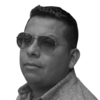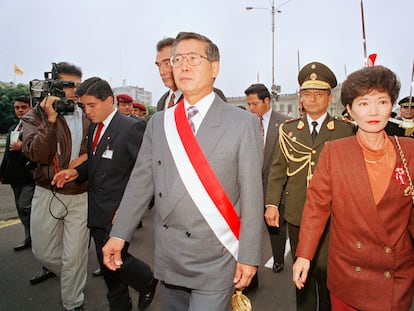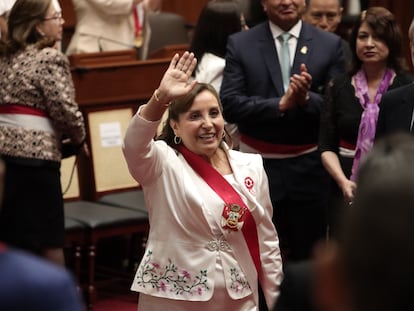Documentary filmmaker detained in Peruvian protests: ‘Police violence is structural and I have experienced it firsthand’
Kenty Aguirre was beaten by agents during the most recent demonstrations, when he was recording an arrest. He intends to sue the officers for torture and abuse of authority
On July 28 – Peru’s independence day – just after two in the afternoon in the center of Lima, a man in a green polo shirt and with dreadlocks was grabbed and dragged by police officers. The agents were stationed there to control the demonstrations being held against the government of President Dina Boluarte.
As this was occurring, just a few blocks away, Peru’s first female president was reading the last paragraphs of her extensive televised message to the nation – a speech that is traditionally given by the head of state during the national holidays.
Meanwhile, in the video taken in the University Park, you can see how an agent grabs the man by the neck. He subsequently faints. He is then dragged by his arms and legs until he’s taken behind a police cordon. The row of shields closing interrupts the footage.
Shanin Kenty Aguirre Figueroa, 34, spent two nights in a cell. The police justified the arrest with the allegation that he was causing a disturbance. One agent says he was throwing stones – another claims that Aguirre kicked him in the testicles. Another says that he bit his hand. They also maintain that Kenty Aguirre had sprayed a white liquid on them and that he was harassing people. But in none of the videos – be it those taken by citizen journalists or the Municipality of Lima – was it possible to corroborate the version of the riot control officers. What was seen minutes before his arrest was the dreadlocked young man – who was sporting a blue helmet – using his cellphone to record the arrest of a community leader. His shirt had been torn and the police were beating him on the ground.
On an August morning, a few weeks after the incident, Kenty Aguirre and his older sister, Kuzy, arrive for their interview with EL PAÍS. He moves with a little difficulty, before sitting down on one of the benches in the University Park. He’s suffering the consequences of the 17 lesions found all over his body.
Kenty wants to explain what happened to him – above all, because he doesn’t want it to happen to someone else. “I never had any confidence in the police. I have witnessed so many abuses… this time, it was my turn. And it’s not that there are simply bad elements – the violence of the police is structural. I have experienced it firsthand,” he affirms.
Aguirre has worked in communications for Peru’s Catholic University over the past decade.
He specializes in audiovisuals – specifically, in cinema and documentaries – and has participated in several shoots as a cameraman and cinematographer. When he was arrested, Peruvians who opposed the demonstrations dismissed him, noting that “he was just another bum.” It’s not very different from what the policemen told him: “Surely you’re a terruco (a terrorist). Look how much you earn. Why are you coming to these marches? You’re wasting your time. Go look for a job.”
On July 28 – which was a Friday – Aguirre went out to record the protests on his own, without having been contracted. He realized that he was “more useful recording and disseminating information than just marching.” He belongs to a group of self-organized photographers. Unfortunately for him, he forgot his memory card, so he had to leave his camera in his backpack and record everything with his cell phone. He was carrying a gas mask, a bottle of bicarbonate water and a case for his glasses.
He says that behind the police cordon – when the cameras could no longer record his arrest – several policemen beat him while he covered himself with his backpack. One of them knocked him down and put his knee on his head. He says they tried to intimidate him, telling him they would cut off his knee-length hair. And that, later, when they put him in the vehicle to take him to the police station, a policeman told him: “You screwed up, now there are no more cameras” and slapped him with an open hand.
“My face didn’t bleed. Most of the blows were to my extremities. It seems that the policemen knew where to hit me, so as not to leave so many marks. My knees are what hurt the most,” he says.
At the Cotabambas police station, in the historic center of Lima, Aguirre limped inside. He was asked to sign a document stating that the arrest procedure had been standard, without violence. He refused to sign. Another detail that he denounced was the attitude of the forensic doctor, Melva Calderón, who had to certify his injuries. “She didn’t seem interested in recording my injuries. She discharged me quickly and I had to insist many times that her report be detailed. I took off my pants – that’s when she saw all my bruises,” he explains. There were 17 injuries to his arms and legs. The most serious is a large bruise on the back of the left thigh.
In the cell, Aguirre – who had lost his glasses during the arrest and couldn’t make out faces in the dark – met Raúl Tinco, the leader whom he had recorded minutes before they dragged him away. Unlike other detainees, Aguirre had a support network and various institutions that spoke up for him. He acknowledges and appreciates this. “I never imagined such solidarity. I know that I have had privileges. Without the videos from alternative media, I don’t know how this would have ended. It’s because of those videos that it was shown that I did nothing but record. It’s the alternative media that deals with the danger and reports facts that many times, the [main] channels don’t show,” he affirms.
Aguirre was released on Sunday, July 30. His case was dropped, as it couldn’t be proven that he had caused a disturbance. But he emphasizes that he won’t let this go – he intends to sue the agents responsible for abuse of authority and torture. For now, it has been possible to identify the non-commissioned officers – Andrei Iván Laurente Sánchez and Francesco Vela Rojas – as well as the senior non-commissioned officer Julio Castro Amoretti. Until today – a month after the events transpired – Aguirre’s cellphone, camera or other belongings haven’t been returned to him. He was only released with his national identity card and his empty backpack.
“The Prosecutor’s Office says that the origin of the property must be proven. That’s absurd. This is only done when a third party is going to collect the property, otherwise it’s theft. This was an arbitrary and illegal detention – an act of intimidation against anyone who films acts of police violence in the marches,” summarizes Aguirre’s lawyer, Juan José Quispe, from the Legal Defense Institute.
Kuzy Aguirre – Kenty’s older sister – chimes in: “When they called home, it would have been less worrying to hear that he was in a hospital, but to know that he was with the police…you don’t know how he’s going to get back. With them, there’s no certainty of what will happen. They’re a big mafia,” she expresses, with a trembling voice.
Shortly before being released, Kenty Aguirre recounts that the policeman who hit him in the car approached him, patted him on the back and whispered: “Take it easy, son, it’s all over now.”
Sign up for our weekly newsletter to get more English-language news coverage from EL PAÍS USA Edition
Tu suscripción se está usando en otro dispositivo
¿Quieres añadir otro usuario a tu suscripción?
Si continúas leyendo en este dispositivo, no se podrá leer en el otro.
FlechaTu suscripción se está usando en otro dispositivo y solo puedes acceder a EL PAÍS desde un dispositivo a la vez.
Si quieres compartir tu cuenta, cambia tu suscripción a la modalidad Premium, así podrás añadir otro usuario. Cada uno accederá con su propia cuenta de email, lo que os permitirá personalizar vuestra experiencia en EL PAÍS.
¿Tienes una suscripción de empresa? Accede aquí para contratar más cuentas.
En el caso de no saber quién está usando tu cuenta, te recomendamos cambiar tu contraseña aquí.
Si decides continuar compartiendo tu cuenta, este mensaje se mostrará en tu dispositivo y en el de la otra persona que está usando tu cuenta de forma indefinida, afectando a tu experiencia de lectura. Puedes consultar aquí los términos y condiciones de la suscripción digital.
More information
Archived In
Últimas noticias
Most viewed
- Reinhard Genzel, Nobel laureate in physics: ‘One-minute videos will never give you the truth’
- Oona Chaplin: ‘I told James Cameron that I was living in a treehouse and starting a permaculture project with a friend’
- Pablo Escobar’s hippos: A serious environmental problem, 40 years on
- Charles Dubouloz, mountaineering star, retires at 36 with a farewell tour inspired by Walter Bonatti
- Why we lost the habit of sleeping in two segments and how that changed our sense of time











































